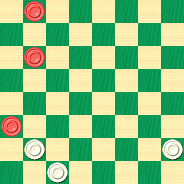The Checker Maven
Jump to navigationIn the Hedges

Today's class in our monthly Checker School series is nearly a miniature, having but three men per side; and, as usual for a Checker School entry, it's eminently practical. Our title is taken from Thomas A. Hedges, who reportedly first solved the problem when it was published well over 100 years ago. Today, it remains a good position to know for the cross-board player.
BLACK

WHITE
White to Play and Win
W:W25,28,30:B1,9,21.
White has an advantage that can't be easily described as very large, but still, it's enough to win. Can you find your way out of the thicket, or will you be scratched by brambles? Have no fear of monsters lurking in the maze; clicking on Read More will rescue you at once and bring you to the solution, a sample game, and detailed notes.![]()
Solution
The solution, sample game, and lettered notes are from Ben Boland's Famous Positions in the Game of Checkers. Numbered notes come from computer analysis with Ed Gilbert's Kingsrow engine and 10-piece endgame database. The note on blindfold play was published on the same page in the original edition of the book.
25-22, 9-14, 28-24, 1-6, 24-19, 6-10---A, 22-17---B, 14-18, 30-26, 21-25---1, 26-22, 18-23, 22-18, 25-30, 18-14. White Wins.
Game: 11-15, 23-19, 9-13, 22-18, 15-22, 25-18, 10-15, 18*-11, 7-23, 27-18, 12-16, 29-25, 8-11, 25-22, 16-20, 24-19, 4-8, 19-16, 2-7, 16-12, 5-9, 22-17, 13-22, 26-17, 11-16, 17-13, 20-24, 28-19, 16-23, 31-26, 8-11, 26-19, 7-10---C, 21-17---D, 10-14, 17-10, 6-22, 13-6, 1-10---E, 32-27, 10-14---F. Forms above position at 5th move, colors reversed, without men on 22 and 30. W: Veal, Game 3859, Weekly Times (Melbourne), Dec. 11, 1937.
A---6-9, 19-16, 9-13, 16-11, 14-17, 22-18, 17-22, 11-7, 22-25, 7-2, 25-29, 2-6, 29-25, 6-9, 25-22, 18-14. White Wins.
B---This move was overlooked in: C. B. Bouton and L. S. Head, No. 66, Vol. 5, American Checker Review, 1893. Black---3, 7, 14, 21 and White—---16, 19, 22, 30. Black to play, 7-11, 16-7, 3-10, how same as above at 6th move. Now 22-17 would win but they continued with 30-26 to a draw. This was noticed by the writer, but he was anticipated by Chas. E. Richardson, Problem No. 1954, in the Old Draughts Board (Checker Column), Jan. 1902.
C---Corrects W. Campbell in England vs. Scotland match, 1884, who continued 11-16, 19-15, 7-10, 2M7, etc., drawn against W. Gardner. For 21-17 play 15-11, 10-15, 11-7, 16-22, 7-2, 16-19, 21-17, 19-23, .17-14, 9-18, 2-9, and White wins; as shown by J. Pirie in Reynolds News, Aug. 8, 1937, Game 1155. W. Veal.
D---32-28, 10-15, 19-10, 6-22, 13-6, 1-10, 21-17, 11-15, 17-13, 15-18, 13-9, 10-14, 9-6, 22-26, 30-23, 18-27, 6-2, 27-32, 28-24, 32-27, 24-19, 27-23, 19-15, 23-18, 15-10, 14:17. Drawn. W. Veal.
E---Forms problem 4057 by W. Veal, White to move, Black Wins.
F---This wins too; 11-16, 27-23, 22-26, 30-25, 26-31, 25-22,. 31-27, 22-18, 10-14. Black Wins.
F---With the extra men Veal continued: 27-24 (27-23 would lose as above), 14-17, 24-20, 17-21, 19-16, 11-15, 16-11, 22-26---G, 30-23, 21-25, 11-8---H, 25-30, 8-4, 30-26, 4-8, 26-19, 8-11, 15-18, 11-8, 18-23, 8-11, 23-27, 11-8, 27-32, 8-11, 32-27, 11-8, 27-23, 8-11, 23-18, 11-8, 18-15, 20-16, 19-24, 8-4, 15-19. Black Wins. Same as note A, colors reversed.
G---15-18, 11-8, 18-23, 8-4, 23-27, 4-8, 27-32, 8-11, 32-27, 11-16, 27-24, 16-11, 24-19, 20-16, 22-25, 30-26, 25-30, 26-22, 30-26, 22-17, 26-22, 17-14, 22-18, 14-9, 18-14, 9-6, 14-9, 6-1 (if 6-2, then crown man on 21, return to Square 13 and exchange), 21-25, 1-5, 9-6, 5-1, 6-2, 1-5, 25-30, 5-9, 30-26, 9-14, 26-22, 14-9, 22-18, 9-5, 19-15, 11-8, 18-23, 8-4, 2-7, 4-8, 23-19, 5-9, 19-24, 9-6, 7-2, 6-9, 24-20. Black Wins.
H---But 11-7, 3-10, 12-8, etc. Draws.
1---18-22 or 18-23 lose in a similar manner as the main line, for instance 18-23 26-22 23-27 22-18 27-31 18-14 White Wins---Ed.
In the Roseville Citizen for Jan. 28, 1937, we found this history by Everett Fuller: "The Chicago players were the first to get a shock about this win. It came up in a game at Chicago before the turn of the century. Charles Hefter published it (a similar setting, see Page 14 Familiar Themes') in the Inter-Ocean as a draw. Thomas A. Hedges, who is the best analyst I have ever met, told Hefter he could win the position. They set it up and Hedges showed an astonished Hefter the win. Later Hedges made the above position, which allows Black an alternative line of play (Note A) that is just as neat as the original."
"Blindfold Play!"---The art of playing blindfold is only of comparatively recent origin, so far as the history of our game records and the first performance was chronicled in the New York Clipper about 1855, played by the then Draughts Editor, Mr. I. D. J. Sweet. A space of fifteen years elapsed before another was heard of, and it was also a New York Player, Mr. De Con who was a performer. Mr. De Con's opponent on that occasion was a Mr. J. H. Correll, and the game appeared in the New York Turf, Field and Farm. Following this closely was the exhibition given by the late Mr. E. Lord in the Secular Club and Institute, Birmingham, in 1870, who contested two games simultaneously, and won both rather easily. Since then many eminent players have cultivated this art, but there can be no doubt that the blindfold exhibition given within the last few years by Stewart of Kelty, Shearer of Dundee, and Willie Gardner of Leeds, are without any parallel; and strange to relate, the first two of these players hare no ambition to be styled the blindfold champions of the world. ---The Draughts World, 1910.
Newell W. Banks is the present Champion, taking the crown from William F. Ryan, in their Blindfold Match of 1937. The score was 2 to 1 and 7 drawn. This was their second match, Ryan won the first.
You can email the Webmaster with comments on this article.
